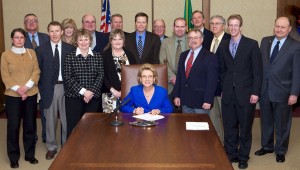Published on
Introducing LiLAs to Washington State

The following interview is with Eleni Papadakis, the executive director of the Workforce Training and Education Coordinating Board of Washington State. Washington recently passed legislation that creates a clear definition of a Lifelong Learning Account. In this interview, Papadakis share some specifics of Washington’s LiLA program and explains some of the strategies that helped the State get to this point.
1. Could you briefly explain how Lifelong Learning Accounts will work in Washington State?
It’s an interesting model that we’ve created because, while it’s in State Statute, it’s not actually a state-run program. It’s designed in a way that independent organizations will operate a LiLA program for whatever businesses are in purview or their area. We started out with thinking about banks or financial institutions being able to run this because LiLA is a savings account program. But the banks or the financial institutions would work with, our assumption is, employers who already use those banks to develop this employee benefit program.
A LiLA is, as I said, a savings account. It’s jointly contributed into by both the employer and the worker. So, depending on how much an employer says they’re willing to contribute per month or per pay period, the employee can put in that much or more if they like, but it will be matched dollar-for-dollar up to an amount. The employee will then use that money to pay for their professional development, educational pathway development, towards bigger and better jobs. We’ve designed this in a way that it’s attractive and accessible to the lowest-wage employees because most education benefit programs don’t really work for those folks, usually because there is a grade average that employers look for before they’ll reimburse tuition. That alone is an issue, sometimes coming up with the tuition up front, but then risking the possibility that you won’t get reimbursed for it. For low-wage employees, that’s a difficult thing.
This is an account that builds up reasonably quickly so that they could take their first course with the money already there and available, fully funded. There’s no grade requirement, there’s no requirement that it has to be within a particular discipline or occupational area. Even if an employee is working, say, for a hospital and has no interest in the healthcare occupations that they might train for, but instead wants to become a chef or a machinist, they’re able to take that money and use it any way that makes sense to get them to the next stage of their career goal.
So the concept that we’ve created in the statute was that we have a turn-key package that any organization can pull down and customize to the employers in their mix and the workers that work for those particular employers.
As I said, we kept the financial institutions in mind. There is something in the US called the “Community Reinvestment Act” that requires that the private financial institutions contribute a certain amount of their profits or revenues back into the community. And we’ve designed this in a way that the program would meet the obligations of the Community Reinvestment Act. We’ve also designed it so that a community-based organization can operate it, an employer or trade-organization, or even an educational institution that wants to create stronger relationships with their local employers.
2. When you say turn-key, what exactly does that mean?
So there will be a complete package available that provides guidance or parameters for all aspects of starting up and then managing a LiLA program.
There will be materials for the employers to help the employers understand what their responsibilities are, for the employees and for the administrator, whoever chooses to take that on, what roles they’ll have to play along the way. One of the components of our LiLA model is that we do require that there be some level of career and educational counseling to help the worker — the LiLA account holder — figure out what possible career options are available to them, what types of training or education needs to be taken, what the pathways might be, where the educational institutions are that could help them achieve their goals. That’s something we know that banks and employers may not really understand or know how to access or develop those programs, so we’ll have some guidance packages on that as well.
So what we mean by turn-key is that you won’t have to think through development all on your own. It will all be laid out. It is designed so that an organization can customize it in a number of different ways, but if they don’t want to do a lot of extra thinking, we’ve kind of laid it out for them.
3. The legislation passed in Washington State defines LiLAs specifically, but does not provide any government funding, after having the initial proposal rejected three years ago. What were the roadblocks you had to overcome to get to this point?
I can boil this down by saying that the LiLA concept is just too elegant and simple.
We mostly ran into cynicism that everybody that participates, benefits. When we talk about the LiLA concept, we say that the beneficiaries are both the employers and the workers. There’s some disbelief that that could possibly be the case, so we’ve needed to do a lot more socializing of the concept. We had a pilot project with a small handful of employers and we ended up with four or five who stuck with it and went through all the paces and helped us design the concept. Those employers served as our champions for those folks who just couldn’t believe that the employers would actually benefit in the ways that we said. So we had a lot of socializing and champion-building through that process. By the same token, we had workers who, for a variety of reasons, didn’t make it through the traditional education pathways when they were young and now, as adults, workers, realize that they need more education to progress economically and down a career path. We worked with those employees who took advantage of LiLA during the pilot to tell their story as well. In fact, we have a couple of videos now on our website where the employers and workers tell their story. Having the stories told from each of their perspectives has been very powerful. We did also have a question about our public policy intention, to create a program that targets or benefits low-wage, low-skilled workers. We had some folks who just couldn’t believe that our program could target those folks in a way that makes it attractive for them to give up any portion of their low salaries into a savings account like this. Again, having the employees talk about how, “yeah it was hard up front to make that decision,” but the payoff to them was tremendous and, actually, as the money was deducted from their pay cheque before they even saw it, they stopped expecting it. It didn’t end up being as much of a burden as they had originally thought.
On the flip-side of that, there were folks who said, “Okay, if you’re targeting this for the most disadvantaged individuals, the lowest-wage workers, how could it possibly be of benefit to higher-wage workers?” So we were able to talk through that as well. We did have a couple of folks in the pile who were middle-skilled individuals, who also said, “I need more education if I’m going to progress beyond this point.” So they told a similar story, obviously not with as many hardships, but the story was the same. All of that was a lot of work and socializing and, as I say, building the right champions to speak to the right policy-makers to help ease their cynicism or questions and concerns. At the point that the new bill was crafted to allow other independent organizations [to] operate LiLAs, it pretty much sailed through at that point.

4. Were there any specific concessions that you had to make when developing this programming, to account for the fact that the United States was, and still is, going through a great significant recession?
The biggest concession is that there is no state-run component of this. While I think we’ve created something that will get legs and start getting out to folks, it’s going to be very difficult to take this to any level of scale without having some kind of support from state entities. There will not be a point person who’s responsible for seeing that this gets out to folks. We will make that happen as best we can within the current resources available, but I can’t assign a person to take this on as even half-time responsibility, at this point, because of the funds that cover our business operations just don’t allow for that. We are in the process of looking for other sources of funds, but even that is difficult when there’s no funding to pay for somebody to do the resource development. That was the concession.
We do work with a large, multi-faceted stakeholder coalition on LiLA. From the beginning, we started out with about 30 different organizations from business labor, higher education, community-based organizations — all of those sectors came together to develop the concepts, identify the problems and then create the solutions, one of which was this LiLA model. The majority of those folks are still on board three, almost four, years later. And they’re working with us to help figure out how to get the message out there to get organizations to take this turn-key package and do something with it.
I have some confidence that it will roll out, but much more slowly than any of us would have liked to see. But in times of seriously reduced revenues in the state and the current economic situation, we couldn’t really ask for a lot more. In fact, I think we’re all very thankful that the legislature went ahead to develop with us this concept of an independently-operated LiLA program.
5. You mentioned that there were clear benefits for employers as well as for the low-wage, low-skilled workers. Is there any one group that LiLAs benefits most?
I think it’s one of those things that anyone can really benefit that takes advantage of it. We have found that the employers who are most interested in LiLA are employers that are too small and don’t have the revenues or profit margins to create fully-funded tuition support programs for their employees. Most of the employers that we meet with understand that there’s some value to offering education support for their employees. They have different versions of what that level of investment should be, or what the return to their business should be. But most employers understand that it’s at least attractive to a large range of potential employees and keeping current employees on board.
The ones who do contact us and get excited about LiLA are the folks who want to do so much more, but just don’t have the resources to do it. So, for our pilot, we had actually initially gone to larger employers who we thought had some discretionary resources available to develop another benefit program for their employees. Those employers, who were known to have robust benefit programs for their employees, might be willing to add one more. We didn’t get a lot of take-up from those folks; the employers who signed up on to the pilot were small and very small employers. One employer only had four employees. For each of those employers, what was clear is that they believed that their workforce was the key to their success. Keeping good employees on board, helping employees develop to higher levels of wage and career progress, was something that they wanted to be able to give to employees to encourage them to stay and grow.
Or, they have a lot of turnover, and they wanted the good employees who benefited and then leave for a better job to help them find the replacement. So they thought, if they could create something that’s really attractive to these folks, help them grow and progress and succeed, those exceptional employees would then find the best of their network of friends and families to take the job after them. Through the pilot… employers can report that that’s the case. For the small, very small, employer, it’s a truly significant benefit to offer.
From the public policy standpoint, we wanted something that would benefit low-wage/low-skilled workers in ways that traditional tuition support programs just don’t and we have seen that come to fruition. Employees who said that there was no way they could think about developing the kind of savings program to get them through college. And also employees who say, “I had no idea what the possibilities were for me, until I sat down with a career counselor who helped me think through what was out there for me and what was the quickest way for me to achieve my goals.”
6. How did you manage to design the LiLA program in Washington State to ensure that no one group was particularly advantaged or disadvantaged by the legislation?
It was a lot of constituent and stakeholder work — really, just talking to folks. As I mentioned, we had business and labor members of the coalition that were helping us think through this. We worked with the Chambers of Commerce, local economic development agencies, to help us think through this. Post-secondary institutions, both private and public organizations, worked with us in thinking through how they currently work with adult workers and what they wanted to see make it easier for a variety of populations of adult workers to access, and benefit from, post-secondary education. It was the coalition, the collaborative of organizations and individuals, that helped us think through every piece of this.
In the last year, we connected with the Division of Financial Institutions — the agency that oversees banking and financial services in Washington State — they were the ones who really helped us think through how we get financial institutions involved, and their commitment was just incredible. I don’t think we could have gotten over that last hurdle of how we create something that isn’t on the backs of the taxpayers to something that could actually take shape out in the independent community.
7. Is there anything you’d like to add about Washington State’s LiLA program?
I would just like to highlight the power of the type of partnership and collaborative that came together. That having the voice of the employer, the voice of the worker and the voice of the education and public sectors together was the powerhouse that moved this concept forward. I do also want to give thanks to the two legislative sponsors who stuck with us from the beginning and carried it over the finish line and that’s Senator Derek Kilmer, who’s just recently been elected to Congress, and Representative Phyllis Kenny, who retired this year after many years of contributing so greatly on this project and so many others.
To learn more about Lifelong Learning Accounts, please click here.
Author Perspective: Government



